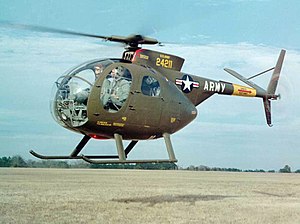OH-6 Cayuse
| OH-6 Cayuse | |
|---|---|
 |
|
| OH-6A Cayuse helicopter on lift off | |
| Role | Light Observation Helicopter / Utility |
| Manufacturer | Hughes Tool Co. – Aircraft Division |
| First flight | 27 February 1963 |
| Introduction | 1966 |
| Status | Active service |
| Primary user | United States Army |
| Produced | 1965–present |
| Number built | 1,420 (OH-6A) |
| Unit cost |
US$19,860 (1966)
|
| Variants |
MD Helicopters MH-6 Little Bird MD Helicopters MD 500 McDonnell Douglas MD 500 Defender |
The Hughes OH-6 Cayuse (nicknamed "Loach", after the requirement acronym LOH — Light Observation Helicopter) is a single-engine light helicopter with a four-bladed main rotor used for personnel transport, escort and attack missions, and observation. Hughes Helicopters also developed the Model 369 as a civilian helicopter, and the Hughes Model 500, currently produced by MD Helicopters as the MD 500.
In 1960, the United States Army issued Technical Specification 153 for a Light Observation Helicopter (LOH) capable of fulfilling various roles: personnel transport, escort and attack missions, casualty evacuation and observation. Twelve companies took part in the competition and Hughes Tool Company's Aircraft Division submitted the Model 369. Two designs, those submitted by Fairchild-Hiller and Bell, were selected as finalists by the Army-Navy design competition board, but the U.S. Army later included the helicopter from Hughes as well.
The first Model 369 prototype flew on 27 February 1963. Originally designated as the YHO-6A according to the Army's designation system, the aircraft was redesignated as the YOH-6A in 1962 when the Department of Defense created a Joint designation system for all aircraft. Five prototypes were built, fitted with a 252 shp (188 kW) Allison T63-A-5A, and delivered to the U.S. Army at Fort Rucker, Alabama to compete against the other ten prototype aircraft submitted by Bell and Fairchild-Hiller. During the course of the competition, the Bell submission, the YOH-4, was eliminated as being underpowered (it used the 250 shp (186 kW) T63-A-5). The bidding for the LOH contract came down to Fairchild-Hiller and Hughes. Hughes won the competition, and the Army awarded a contract for production in May 1965, with an initial order for 714 that was later increased to 1,300 with an option on another 114. Hughes's price was $19,860 per airframe, less engine, while Hiller's price was $29,415 per airframe, less engine. The Hiller design (designated OH-5A) had a boosted control system, while the Hughes design did not. This would account for some of the price difference. Hughes is reported to have told Jack Real that he lost over $100 million in building 1,370 airframes. It was reported that Howard Hughes had directed his company to submit a bid at a price below the actual production cost of the helicopter in order to secure this order, resulting in substantial losses on the U.S. Army deal, with the anticipation that an extended production cycle would eventually prove financially viable.
...
Wikipedia
